Invasive alien species are generally accepted as being one of the top three threats to biodiversity worldwide, but until now there has been no metric for assessing the magnitude problem globally, its impact and our responses to it.
In a recent paper published in Diversity and Distributions, C·I·B core team member Prof. Melodie McGeoch and a team of co-workers derived a set of four indicators that will enable us to monitor changes in the extent and magnitude of invasions and their impacts, and to assess the extent to which policy responses are addressing the problems. The study is an important contribution to the Convention on Biological Diversity’s 2010 Biodiversity Target.
The study revealed that:
- We are significantly underestimating the size of the problem, because the majority of countries have inadequate data on even the identity of invasive alien species present in the country.
- There is a strong link between economic development and a country’s capacity to manage the invasive alien species problem. This emphasizes the importance of integrating poverty alleviation and conservation agendas.
- Invasive alien species are having a net negative impact on biodiversity. Red List Indices show that the extinction risk of birds, mammals and amphibians is increasing over time (as shown by the movement of species through categories on the IUCN Red List).
- Although some threatened species have improved in status (and been downlisted on the IUCN Red List) as a result of successful control or eradication of invasive species, more have been uplisted owing to increasing spread and threats from invasive species (examples are given in the paper).
- Policy responses have been in the right direction — there are now ten international conventions and agreements with provisions for tackling invasive species, and over 80% of eligible countries have signed up to these.
- Only slightly more than half of countries have national legislation for tackling the problem. Even fewer have cohesive strategies and implementation plans for on-the-ground-management.
- On a positive note there has been an exponential increase in countries becoming signatory to international agreements relevant to controlling invasive alien species since the 1970s, with the large majority of countries signatory to more than one such agreement.
- There is also clear evidence of improvement in the conservation status of selected species as a direct consequence of actions to control invasive alien species.
- The cost associated with the impact and control of invasive alien species appears to far exceed the cost of the investment required for research and prevention.
Website Invasive Alien Species Indicator

Front cover: Representing a key threat to biodiversity, invasive alien species (IAS) form the basis for one of the indicators used for reporting on progress towards meeting the Convention on Biology Diversity’s 2010 Biodiversity Target. McGeoch et al. (pp. 95-108) show that not only is there now documented evidence of significant numbers of alien species having negative biodiversity impacts worldwide, but IAS have been directly and indirectly responsible for the decline in conservation status of many species. For example, house mice (Mus musculus) kill chicks of the Endangered Atlantic Petrel Pterodroma incerta) on Gough Island and contributes to the species’ poor breeding success and ongoing rapid declines (central photo: Andrea Angel and Ross Wanless; Wanless et al., 2007). Examples of Critically Endangered birds threatened by IAS include (from left to right): the Juan Fernández Firecrown (Sephanoides fernandensis) threatened by a range of introduced plant and animal IAS on Isla Robinson Crusoe, Juan Fernÿndez Islands, Chile (Credit: Rare Birds Yearbook/Peter Hodum); the Polynesian Ground-dove (Gallicolumba erythroptera) threatened by cats and rats on islands in French Polynesia (Credit: Rare Birds Yearbook/Pete Morris); the Akohekohe (Palmeria dolei), threatened by introduced disease-carrying mosquitoes on Maui, Hawaii (Credit: Rare Birds Yearbook/Aaron French). (Cover design: K. Coombe-Davis).



